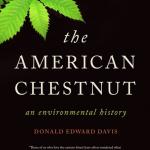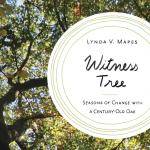A monthly e-newsletter from UMass Extension for landscapers, arborists, and other Green Industry professionals, including monthly tips for home gardeners.
Click on the headings below to jump to that section of the newsletter.
In This Issue
- The 2025 UMass Garden Calendar... Makes a Great Holiday Gift!
- Understanding Salt in the Soil
- Pseudocercospora leaf blotch of lilac (Syringa vulgaris)
- Q&A - EAB on fringetree, Joro spiders, and southern yellowjackets
- Garden Clippings: Tips of the Month
- A Summary of Noteworthy Tree-Related Books
To print this issue, either press CTRL/CMD + P or right click on the page and choose Print from the pop-up menu.
The 2025 UMass Garden Calendar... Makes a Great Holiday Gift!
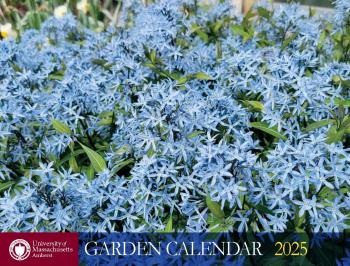 UMass Extension works with the citizens of Massachusetts to help you make sound choices about growing, planting, and maintaining plants in our landscapes, including vegetables, backyard fruits, and ornamental plants. Our 2025 calendar continues UMass Extension’s tradition of providing gardeners with useful and practical information. Many people also love the daily tips and find the daily sunrise/sunset times highly useful!
UMass Extension works with the citizens of Massachusetts to help you make sound choices about growing, planting, and maintaining plants in our landscapes, including vegetables, backyard fruits, and ornamental plants. Our 2025 calendar continues UMass Extension’s tradition of providing gardeners with useful and practical information. Many people also love the daily tips and find the daily sunrise/sunset times highly useful!
As always, each month features:
- An inspiring garden image.
- Daily gardening tips for Northeast growing conditions.
- Plenty of room for notes.
- Low gloss paper for easy writing.
- Daily sunrise and sunset times.
- Phases of the moon.
Images in the calendar, details, and ordering info...
COST: $14.50, with bulk pricing rates apply to orders of 10 copies or more. Remember to order by December 1 for guaranteed Christmas delivery!
Proceeds from sales of the annual Garden Calendar benefit the work of UMass Extension’s educational programs.
Understanding Salt in the Soil
What kind of salt is in the soil?
It can be a little confusing to understand exactly what is meant by salt in soil. There are a number of words that come up and that you might see on soil tests, Extension factsheets, and horticultural guides. This confusion stems from the fact that we use the same word – salt – to talk about both 1) any solid material that dissolves in water as positively and negatively charged bits and 2) one specific material – sodium chloride or rock/table salt. This makes it important to understand the terminology.
Salinity, or soluble salt content, refers broadly to the amount of any type of salt present in the soil. The salts could be dissolved in the soil water, attached to soil particles on cation exchange sites, or as crystals in particularly saline dirt. When the salts are split into their charged halves, the halves are often called ions.
Sodicity refers to the amount of sodium ions in the soil. This can occur independently of salinity, but it’s definitely possible for soil to have both high salinity and sodicity.
What does salt do in soil?
Salts affect both soil physical properties and soil water dynamics. A high concentration of salts in general can draw water out of plant tissues... killing them. This desiccation can also happen directly on aboveground leaves and stems in direct contact with water-soluble fertilizer or fresh manure. Sodium in the soil also causes soil aggregates to fall apart more easily, leading to reduced water infiltration and percolation. Excess sodium in the absence of other salts also leads to high pH (>8.5).
How much salt is too much?
For salinity, it mostly depends on the variety of plant. Some plants are more tolerant of salinity. In many cases, water management can reduce salts but if there is a chronic salt problem, choose tolerant species and varieties. Because more salts in the soil water make it carry electricity more easily, salinity is measured in the laboratory and reported as electrical conductivity, with above 0.6 dS/m considered saline by the UMass Soil Testing Lab. Remember than many plants can tolerate mild to moderate salinity.
More than 15% sodicity is considered problematic. This is when more than 15% of the small, positively-charged molecules (cation salts) are sodium atoms. The amount of sodium that it takes to make dirt sodic depends on the overall amount of space in the soil for cations. This cation exchange capacity (CEC) is higher in fine-textured soil or in dirt with higher organic matter levels so these soils can contain more total sodium before becoming sodic.
How does dirt get salty?
Salinity in Massachusetts is uncommon in soil outside of protected environments (high tunnels, potted plants) because we get enough rain to keep excess salts from accumulating in the root zone. Temporary high salinity can also occur after manure and fertilizer application (especially in dry weather) or from ice melting salt (especially in spring).
Sodicity occurs from the use of rock salt (sodium chloride) on roads and sidewalks in the winter. It is primarily a problem if salted snow is collected near plants or if rock salt is accidentally spread on plants outside of pavement.
What can be done about salty soil?
As with many things, prevention is ideal. Be careful spreading rock salt, use composted manure when possible, and keep fertilizer from direct contact with plants in dry conditions.
If salts build up in a high tunnel or in pots, flushing the soil (or other growing media) with a large amount of water will carry out the excess salts. In a high tunnel, this can be done by irrigating for several days straight. In pots, slowly add double the pot’s volume of water. Make sure to empty any drip plate so that the salts are not reabsorbed over time.
In sodic dirt, gypsum should be added before flushing the soil because it helps to loosen the sodium that is attached to clay and organic matter.
You may notice that these methods require good water drainage. If drainage is poor, it is very difficult to remove either sodium or salts in general; extra attention should be paid to prevention and salt tolerant plants need to be used if salt accumulation is already a problem.
Further Reading
The Impact of Salts on Plants and How to Reduce Plant Injury from Winter Salt Applications
Impact of Road Salt on Adjacent Vegetation
Salt Measurements and Soil Classifications
Arthur Siller, UMass Extension Soil Health Educator
Trouble Maker of the Month
Pseudocercospora leaf blotch of lilac (Syringa vulgaris)
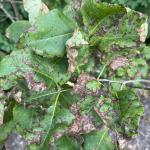
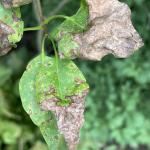
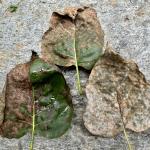 In 2023 and 2024, lilacs (Syringa vulgaris) in southern New England have suffered from a serious late season foliar disease caused by the fungal pathogen Pseudocercospora. Overall, relatively little is known about the disease, but it has been widely reported from lilacs in the Midwest prior to the outbreak here. While poorly studied on lilac, Pseudocercospora species are well known pathogens of many other woody and non-woody plants. Symptoms of Pseudocercospora leaf blotch typically develop sometime in mid-summer, but can be easily missed without careful scouting. Humid conditions with plentiful rainfall spur asexual spore production, dispersal and germination. In August and early September, symptoms intensify and appear as: (1) light to dark brown spots and blotches scattered across interior portions of the leaf, and; (2) a progressively worsening marginal leaf blight. As individual leaf spots coalesce, large necrotic blotches can form, leading to a complete foliar blight. The record-setting rainfall in July of 2023 is likely to blame for the severe outbreak last year. This created a large amount of overwintering inoculum that helped to fuel another outbreak in 2024. While the summer 2024 was very dry across much of the Commonwealth, the mild and wet conditions in the spring combined with abundant inoculum likely allowed for widespread disease establishment.
In 2023 and 2024, lilacs (Syringa vulgaris) in southern New England have suffered from a serious late season foliar disease caused by the fungal pathogen Pseudocercospora. Overall, relatively little is known about the disease, but it has been widely reported from lilacs in the Midwest prior to the outbreak here. While poorly studied on lilac, Pseudocercospora species are well known pathogens of many other woody and non-woody plants. Symptoms of Pseudocercospora leaf blotch typically develop sometime in mid-summer, but can be easily missed without careful scouting. Humid conditions with plentiful rainfall spur asexual spore production, dispersal and germination. In August and early September, symptoms intensify and appear as: (1) light to dark brown spots and blotches scattered across interior portions of the leaf, and; (2) a progressively worsening marginal leaf blight. As individual leaf spots coalesce, large necrotic blotches can form, leading to a complete foliar blight. The record-setting rainfall in July of 2023 is likely to blame for the severe outbreak last year. This created a large amount of overwintering inoculum that helped to fuel another outbreak in 2024. While the summer 2024 was very dry across much of the Commonwealth, the mild and wet conditions in the spring combined with abundant inoculum likely allowed for widespread disease establishment.
A large number of lilacs in the region were defoliated by Pseudocercospora leaf blotch by early autumn in 2023 and again in 2024. In some cases, another foliar disease pathogen (Septoria) was also present. Septoria is similar in that there are many species in the genus that attack a wide array of deciduous trees and shrubs. Septoria leaf spot often appears later in the growing season on hosts such as dogwood and birch. Lilac powdery mildew (Microsphaera syringae) has also been abundant the past two years and was a contributed to the early leaf shedding. In 2023, many defoliated lilacs had a sporadic flush of new growth and flowers in September and early October. Subsequently, this tender new growth did not have time to harden off and died over the winter. In 2024, this late season flush was relatively uncommon.
While lilacs are extremely hardy, two successive years of early defoliation in combination with drought stress from this past summer could result in canopy dieback. Stressed lilacs are also more susceptible to opportunistic cankering pathogens (e.g. Phomopsis) and insect pests. Therefore, thoroughly collect and remove all diseased foliage from sites with Pseudocercospora. This will help to reduce overwintering inoculum used by the pathogen to initiate new outbreaks in 2025. However, keep in mind that the pathogen is widespread in the environment and even with good cultural control, the disease can reappear. Prune and discard blighted twigs and branches throughout the canopy during this upcoming winter. For mature and dense lilacs, consider thinning out the canopy to allow for better air flow and sunlight penetration. Foliar disease fungi thrive in shaded and moist areas of the inner canopy. There are no chemicals labeled specifically for use against Pseudocercospora on lilac. However, both propiconazole and copper hydroxide are labeled for use on lilac in Massachusetts. These broad-spectrum, contact fungicides should have utility against the pathogen. While the exact timing is unknown, fungicide applications should be made early in the growing season and on regular intervals until the foliage is fully developed. However, avoid fungicide application while lilacs are in bloom to reduce the impact on pollinators. Mild (i.e. temperatures >75°F) and humid conditions are conducive to spore production and disease development. If we experience a dry spring and early summer, the fungicide application interval can likely be extended. Scout plants carefully during the month of July for any symptoms and make spot treatments as necessary to suppress further disease development.
Nicholas J. Brazee, UMass Extension Plant Pathologist
Q&A
Q: I just came across this article on EAB (emerald ash borer; Agrilus planipennis) and its impact on white fringetree (Chionanthus virginicus). Have you heard of fringetrees being impacted up here [in Massachusetts]? It sounds like there’s really nothing you can do.
A: In recent years, managers in the Boston, MA area have been concerned about the health of large, old white fringetrees in the presence of emerald ash borer which is now considered widely distributed throughout Massachusetts. White fringetree, although not a favored host plant of this insect, is sometimes attacked by EAB which can complete its life cycle using fringetrees as a host (Ellison et al., 2020). Researchers in Ohio (such as Dr. Don Cipollini of Wright State University in Dayton, Ohio and coauthor of the 2020 publication below) have more experience with EAB on this host plant than we do as of yet in Massachusetts. However, the information serves as a good warning and example of what we might expect from this insect on this host, and how we might manage it.
Dr.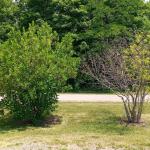 Cipollini writes in a 2023 personal communication on the subject: "[White fringetrees] continue to get attacked occasionally, sometimes severely. [Here is a picture] ...of two fringetrees along a bike trail. The one on the right was heavily attacked by EAB in the last two years, while the one of the left was virtually untouched as of yet. This displays the sort of variation in attack we've seen on these trees. As for whether you should treat, it probably would be worth treating a prized 100-year old tree. You could treat a fringetree with the same formulations and frequency as for ash trees, with a caveat that a root drench may work best due to the multi-stemmed nature of these trees. If you do, however, you should recognize that white fringetree has flowers that are visited by pollinators and it produces fruits that are consumed by mammals and birds and such, so there is greater potential for non-target effects than for ash trees. As you can see in the picture, EAB will attack relatively small trees too, so although larger and older are likely bigger targets on average, we've seen trees down to 4 feet tall and an inch in diameter being attacked."
Cipollini writes in a 2023 personal communication on the subject: "[White fringetrees] continue to get attacked occasionally, sometimes severely. [Here is a picture] ...of two fringetrees along a bike trail. The one on the right was heavily attacked by EAB in the last two years, while the one of the left was virtually untouched as of yet. This displays the sort of variation in attack we've seen on these trees. As for whether you should treat, it probably would be worth treating a prized 100-year old tree. You could treat a fringetree with the same formulations and frequency as for ash trees, with a caveat that a root drench may work best due to the multi-stemmed nature of these trees. If you do, however, you should recognize that white fringetree has flowers that are visited by pollinators and it produces fruits that are consumed by mammals and birds and such, so there is greater potential for non-target effects than for ash trees. As you can see in the picture, EAB will attack relatively small trees too, so although larger and older are likely bigger targets on average, we've seen trees down to 4 feet tall and an inch in diameter being attacked."
With emerald ash borer almost ubiquitous throughout Massachusetts, and high mortality rates of the insect’s favored host plants (ash; Fraxinus spp.) protecting large, old white fringetree in the state might not be a bad idea for land managers. More information about managing emerald ash borer is available in UMass Extension’s Professional Insect & Mite Management Guide for Woody Plants.
References:
Q: Joro spiders (Trichonephila clavata) received a lot of attention in the media in 2024. I heard one was found in Boston, MA. Do I need to worry about this? What should I do if I think I’ve seen a Joro spider?
A: Joro spiders are nothing to panic about. Despite their large size and venom, they are “shy”, reluctant to bite, and even if they do - the venom is typically weak and not medically important. (UMass Extension cannot provide medical advice. If you are bitten by a spider, see your primary care physician for treatment instructions.)
 While the report recently made in Boston seems to be a verifiable report, Joro spiders are currently not widespread throughout Massachusetts. The egg stage is the known overwintering life stage, and adult activity should end with the first hard frost, although these spiders may be a little cold tolerant given their native climate. The arrival of a Joro spider in Boston, MA is another good example of how mobile non-native arthropods can be.
While the report recently made in Boston seems to be a verifiable report, Joro spiders are currently not widespread throughout Massachusetts. The egg stage is the known overwintering life stage, and adult activity should end with the first hard frost, although these spiders may be a little cold tolerant given their native climate. The arrival of a Joro spider in Boston, MA is another good example of how mobile non-native arthropods can be.
If you think you’ve seen a Joro spider, take a high-quality photo (in-focus) and submit your observation here at the Joro watch website. This will also notify the MA Department of Agricultural Resources of the observation. While UMass Extension does not have an arachnologist on staff (someone who studies spiders and related organisms), there is a laboratory at UMass Lowell that specializes in spiders that may have more information available about this species and other arachnids in their research.
Q: How prevalent is the southern yellowjacket (Vespula squamosa) in Massachusetts? I’ve heard that they may be an issue in Connecticut and other parts of New England.
A: The southern yellowjacket, (Vespula squamosa), does not appear to be very prevalent in Massachusetts at this time. Further research could shed some light on their distribution in the state. Nonetheless, this species is recently receiving a lot of attention in the news. If you suspect you’ve seen one, you can report them here on iNaturalist .
 In general, conflicts between yellowjackets and people increase in the fall (August through September). This includes both native species, such as the eastern yellowjacket (Vespula maculifrons), and introduced species with a longer history and presence in the state (the German yellowjacket, Vespula germanica). This is because the number of yellowjackets per colony increases from spring through fall, with peak numbers occurring around late summer holidays, like Labor Day. They also like the same foods we like to eat outside at picnics and fairs – yellowjackets forage primarily for sugar at the end of the season. This is in contrast to earlier in the year, when foragers primarily hunt for insect protein. Yellowjackets are also attracted to overripe fruit left on plants.
In general, conflicts between yellowjackets and people increase in the fall (August through September). This includes both native species, such as the eastern yellowjacket (Vespula maculifrons), and introduced species with a longer history and presence in the state (the German yellowjacket, Vespula germanica). This is because the number of yellowjackets per colony increases from spring through fall, with peak numbers occurring around late summer holidays, like Labor Day. They also like the same foods we like to eat outside at picnics and fairs – yellowjackets forage primarily for sugar at the end of the season. This is in contrast to earlier in the year, when foragers primarily hunt for insect protein. Yellowjackets are also attracted to overripe fruit left on plants.
If you encounter wasps while eating outdoors, the best practice is to let them help themselves to the food. Avoid swatting at them, as this could invoke defense behaviors. After they have gone, take precautions to cover, finish, or remove the food.
The presence of yellowjackets stops as soon as we receive the first hard frost of the season. All the workers are killed at that time. Only a single queen will overwinter, and she will emerge next spring to begin her own colony.
To learn more about yellowjackets in Massachusetts, visit this newly updated fact sheet by Tawny Simisky and Nicole Bell which discusses the above species, coexisting with or managing yellowjackets, tips to protect property managers and more!
Garden Clippings: Tips of the Month
November is the month to . . . .
- Apply lime to the lawn and/or garden. If a soil test recommends raising the soil pH, apply lime as recommended. Applying lime in the fall allows adequate time for the lime to react with the soil to raise the soil pH. This can take as long as 4-6 months, so a fall application will help prepare the soil for the next year’s growing season.
- Mulch berries and perennials. Organic mulch helps to moderate temperature fluctuations to protect plants from frost heaving caused by freezing and thawing of the soil. Fall mulch application can also help smother winter annual weeds, decrease runoff and increase water retention for the following summer. Mulches also protect the soil from compaction by rain and foot traffic. Apply mulch after the first hard freeze
- Remove spent plants. Spent vegetable plants and annuals should be removed from the garden to reduce the risk of disease carryover to the next season. Perennial plants that die to the ground can also be removed except for disease free ornamental grasses, Echinacea (coneflower), Eutrochium (Joe-Pye weed), and Rudbeckia (black-eyed Susan) that can provide birds with seeds and create vertical accent during the winter.
- Rake leaves and remove mummified fruit. Leaves and mummified fruit from ornamental and fruit trees that were diseased should be raked, removed and destroyed to reduce the amount of disease pathogens carried over to the next season. The leaves and mummified fruits should not be thrown into the compost pile. Fungi that cause leaf and fruit spots can over-winter in infected debris in soil or under the plants. They stay in a dormant state until the following spring when rains and warmer weather induce the production of spores which are disseminated by wind and rain to create new infections. Removal of infected plant material helps to reduce the amount of disease pathogens present in the area, thus reducing the amount of potential disease for the next season.
- Remove fallen leaves from the lawn, or mulch finely. Accumulated leaves on the lawn prevents sunlight from reaching the turf during this important time of lawn growth. Accumulating leaves can greatly reduce photosynthesis, slow the growth of turfgrasses, and also affect their acclimatization for the dormant winter season. A thick layer of leaves can also smother the grass. Rake the leaves off and put them on the compost pile, or if capable equipment is available, mulch the leaves into the turf canopy.
- Service the lawn mower. You can take your lawn mower to your local small engine service shop or service it yourself. To service the lawn mower first empty it of gas. Stale gas is a major problem with lawn mowers and other small engine equipment. When the lawn mower sits in storage for several months, water condenses in the gas tank and gets into the gas, causing problems. To empty the gas, turn on the engine and let it run for about 30 seconds to one minute, then shut it off and siphon the gas. Restart the engine and run it until it stops. After emptying the gas, remember to change the oil, the spark plugs and air filters. Always follow the directions in the owner’s manual.
- Keep evergreen shrubs well-watered. Deep late fall watering ensures that the roots of the shrubs take up enough water to keep them hydrated during the winter. Broadleaf evergreens such as rhododendrons, holly, boxwood and mountain laurel can lose considerable amounts of moisture through their leaves during the winter months. The loss of water is mainly due to strong winds and sun. Winter sun and wind can cause excessive foliage water loss while the roots are in frozen soil and unable to replace lost water. This results in desiccation and browning of the plant tissue. To prevent desiccation injury, deeply water broadleaf evergreens in late fall if the soil is dry and continue watering on a regular basis until the ground freezes.
- Protect tender evergreens shrubs from winter damage. Broadleaf evergreens such as rhododendrons, holly, boxwood and mountain laurel, are susceptible to dry, cold winter winds which can cause desiccation of leaves. During the winter when the soil is frozen, evergreen shrubs can lose water faster than they can take it up, especially if they are exposed to cold dry winds. The leaves get desiccated and appear brown and dead in late winter and spring. You can protect the plants by erecting wind breaks made of burlap attached to frames on the side facing the prevailing winds. Stakes can be placed about 12-18 inches away from the plant to support the burlap barrier to buffer the wind.
- Reduce watering and fertilizer application to house plants. During the months of cold temperatures and shorter days, the growth of most house plants slows down. During this period new growth is minimal. Reduce fertilizer application and watering for house plants until spring when new growth resumes.
Geoffrey Njue, UMass Extension Sustainable Landscapes Specialist
A Summary of Noteworthy Tree-Related Books
Davis, D.E. 2021. The American Chestnut: An Environmental History. The University of Georgia Press. Athens, GA. 368 pp. ISBN 978-0-8203-6045-4
Written for a broad-based audience of natural historians, tree enthusiasts, ecologists, and the public-at-large, The American Chestnut: An Environmental History is an intently-researched resource produced by author and research scholar (Harvard University’s Harvard Forest, Petersham, MA) Donald Edward Davis. Comprised of 4 parts, 12 chapters and a conclusion, this 368-page hardcover book is revealing, illuminating, and perhaps most prevailing of all, brimming with historical realities about the importance of various facets of the American chestnut (Castanea dentata), from its wood to its fruit, and the impacts to our natural environment as well as our society – both past and present. This book helps us understand that though perhaps functionally extinct, through the existence of survivor populations and the sustained efforts of individuals dedicated to its continuation that include conscientious, skilled tree care professionals, agency specialists, and members of the research community (i.e., academics), the once-prolific American chestnut will one day again flourish. This resource is composed in a manner that is enjoyable to all and surely engaging to any tree enthusiast.
Ennos, R. 2020. The Age of Wood: Our Most Useful Material and the Construction of Civilization. Simon & Schuster, Inc. New York, NY. 318 pp. ISBN 978-1-9821-1473-2
Of interest to a wide audience of wood-workers, tree-advocates, construction professionals and the public-at-large, The Age of Wood: Our Most Useful Material & the Construction of Civilization is an intently-researched resource produced by author and Visiting Professor of Biological Sciences (University of Hull, U.K.) Roland Ennos. Comprised of 4 parts and 15 chapters, this 318-page hardcover book is rife with historical realities about the importance of wood and the way we live. From the feverish search for suitable trees for the naval fleets of the two western rivals and military powers of the 18th century – England and France – to the pre-revolutionary Pine Tree Riot of Weare, NH, The Age of Wood…guides the reader through a detailed background regarding trees, wood, and their relationship to human evolution and development. Though the author mentions that forests will ultimately regrow and recover from disturbance and that massive-scale environmental catastrophe has been avoided, the book is undergirded with a cautionary theme about modern-day deforestation and the large-scale logging of untouched forests, including those of the Amazon. An estimated 3-trillion trees cover 30% of the earth’s terrestrial surface, yet the author posits that pristine or old growth forested areas remain at risk and that we must strive to ultimately “mend” our relationship with trees, forests, and the wood that they produce.
Dirr, M.A. and K.S. Warren. 2019. The Tree Book: Superior Selections for Landscapes, Streetscapes, and Gardens. Timber Press. Portland, OR. 939 pp. ISBN 978-1-60469-714-8
Intended for professionals and tree lovers alike that are interested in substantially deepening their knowledge-base and understanding about the identification, selection, and propagation of ornamental trees, The Tree Book is an intently-researched resource produced by world-renowned plant experts, Dr. Michael Dirr and Keith Warren. This 939-page hardcover book is informative, enlightening, and perhaps most powerful of all, filled with praise-worthy, professional-quality color photos of trees. The authors introduce the reader to their deep connection with trees that began in their youth:
“For both of us, this love affair began early in life – with the deciduous monarchs of the Midwest (for Dirr) and the great coniferous rainforests of the Pacific Northwest (for Warren).” (p.8)
They also detail specific memories and moments relating to interactions with trees:
“Whether walking through the redwoods of California, admiring the massive structure of a Midwest oak, or perhaps having exited a hot freeway pulling into the cool deciduous shade of a tree-lined street in an eastern city, we never cease to be amazed by the majesty of trees...doubtless our bond with trees is unusually strong, as the two of us feel kindred spirit with trees…to us, it seems to be a part of our humanity.” (p.9)
The authors include important details about human health benefits, economic benefits and environmental benefits associated with urban trees; they also describe the consequences of invasive insects and the importance of urban tree diversity. Trees that are detailed in this book are arranged in alphabetical order, commencing with the botanical spelling of the genus. Thus, the heart of this book commences on p. 36 with color photos and descriptions of fir (Abies spp.) trees, continuing through to the final species, Chinese date (Ziziphus jujuba), on p. 919. This resource is a must-have for any tree enthusiast – novice or veteran.
Mapes, L. 2017. Witness Tree: Seasons of Change with a Century-Old Oak. Bloomsbury Publishing. New York, NY. 224 pp. ISBN 978-1-63286-253-2
Composed for an audience interested in gaining a deeper, first-person appreciation and understanding of the prominence of trees in our forested landscapes, Witness Tree is a deeply-researched resource produced by renowned author and environmental ambassador, Lynda Mapes. This 224-page hardcover book is written from such a profoundly introspective place that it almost immediately transports the reader into the world of the author. The body of the book details how Mapes decided that a century-old red oak that measured 83.5’ in height, featured a crown spread of 60’ and trunk diameter of 32” would be the witness tree that she would study for her time as a Bullard Scholar at Harvard Forest in Petersham, MA:
“Sprouted from an acorn there by that [stone] wall, the [red] oak was a cultural tree, and a historical artifact. Left, rather than cut, it was a witness to all the changes that had come over this landscape.” (p.17, 18)
In detailing the rich tradition of the study of phenology – the “timing of biological phenomena in nature and their relationship with the earth’s environment…” (p.131), she not only contextualizes the long-term observations made at Harvard Forest by scientists but also places a much-needed emphasis on this practice. From nutrient cycling to water purification, to leaf flush, forests compose a critical component in the natural world, and Mapes highlights how firsthand observation of these attributes can be an important piece of educating others. Readers of this book owe the author a debt for reminding us just how much the signs and wonders of nature – often readily observed through occurrences directly related to trees – should matter.
Jonnes, J. 2016. Urban Forests: A Natural History of Trees and People in the American Cityscape. Viking. New York, NY. 394 pp. ISBN 9780670015665
Of interest to both popular and professional audiences interested in gaining a deeper understanding of the history of trees and people in the United States, Urban Forests is a widely-ranging deeply researched resource produced by renowned author and ambassador of trees, Jill Jonnes. This 22-chapter, 394-page book is informative, enlightening and features accounts with, and interviews from, some of the world’s foremost authorities in urban forestry. It is written in a manner that is engaging to the casual reader, and surely gripping to any tree enthusiast; with a nod to pioneering professionals like J. Sterling Morton, Elisa Scidmore, David Bloniarz, Charles Sprague Sargent, and David Nowak, it enlightens the reader to the “human” side of the urban forestry profession. It also, however, delves into important environmental considerations including the widespread loss of urban trees due to invasive pests that include Emerald Ash Borer, Dutch Elm Disease and Chestnut Blight. This book appropriately gives trees the prominence they deserve in relation to everyday society from their place in art and tale, to their presence among the streets, parks, and national monuments in Washington, D.C. It closes with an “afterword” that recaps the historical and cultural significance of trees to U.S., as well as discusses the important contribution of researchers studying the impacts of trees on human well-being – work that attracted Jonnes to considering the importance of urban forests and urban greenery in the first place.
Richard W. Harper, Professor and Extension Urban Forestry Specialist, Department of Environmental Conservation, UMass Amherst
Additional Resources
For detailed reports on growing conditions and pest activity – Check out the Landscape Message
For professional turf managers - Check out our Turf Management Updates
For commercial growers of greenhouse crops and flowers - Check out the New England Greenhouse Update website
For pollinator interests - Check out the Pollinator Buzz
For home gardeners and garden retailers - Check out our home lawn and garden resources
TickTalk webinars - To view recordings of past webinars in this series, go to: https://ag.umass.edu/landscape/education-events/ticktalk-with-tickreport-webinars
Diagnostic Services
Landscape and Turf Problem Diagnostics - The UMass Plant Diagnostic Lab is accepting plant disease, insect pest and invasive plant/weed samples. By mail is preferred, but clients who would like to hand-deliver samples may do so by leaving them in the bin marked "Diagnostic Lab Samples" near the back door of French Hall. The lab serves commercial landscape contractors, turf managers, arborists, nurseries and other green industry professionals. It provides woody plant and turf disease analysis, woody plant and turf insect identification, turfgrass identification, weed identification, and offers a report of pest management strategies that are research based, economically sound and environmentally appropriate for the situation. Accurate diagnosis for a turf or landscape problem can often eliminate or reduce the need for pesticide use. See our website for instructions on sample submission and for a sample submission form at http://ag.umass.edu/diagnostics.
Soil and Plant Nutrient Testing - The lab is accepting orders for Routine Soil Analysis (including optional Organic Matter, Soluble Salts, and Nitrate testing), Particle Size Analysis, Pre-Sidedress Nitrate (PSNT), Total Sorbed Metals, and Soilless Media (no other types of soil analyses available at this time). Testing services are available to all. The lab provides test results and recommendations that lead to the wise and economical use of soils and soil amendments. For updates and order forms, visit the UMass Soil and Plant Nutrient Testing Laboratory web site.
Tick Testing - The UMass Center for Agriculture, Food, and the Environment provides a list of potential tick identification and testing options at: https://ag.umass.edu/resources/tick-testing-resources.
